![]()
![]()
![]()
Use LEFT and RIGHT arrow keys to navigate between flashcards;
Use UP and DOWN arrow keys to flip the card;
H to show hint;
A reads text to speech;
37 Cards in this Set
- Front
- Back
|
The Hypothalamus is a one of (4) divisions of what?
|
The hypothalamus is a division of the DIENCHPHALON.
|
|
|
What are the (4) divisions of the diencephalon?
|
Diencephalon:
1. Dorsal Thalamus 2. Subthalamus 3. Hypothalamus 4. Epithalamus |
|
|
The (3) responses coordinated by the Hypothalamus are:
|
1. Autonomic
2. Behaviors 3. Endocrine |
|
|
The borders of the Hypothalamus are:
Ant: Post: Med: Lat: Dorsal: Ventral: |
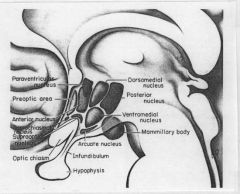
The borders of the Hypothalamus are:
Ant: Lamina Terminalis Post: Mammilary Bodies Med: 3rd Ventricle Lat: Subthalamus Dorsal: Hypothalamic Sulcus Ventral: Pituitary Gland |
|
|
What are the (5) Cytoarchitechural Regions of the Hypothalamus?
(What region is not structurally part of the hypothalamus but functionally related?) |
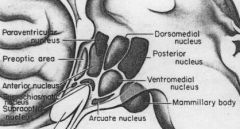
1. Preoptic Area
2. Supraoptic area 3. Tuberal region 4. Mammillary region 5. Lateral hypothalamic area (Circumventricular Organs - lamina terminalis and subfornical organ) |
|
|
What region is not structurally part of the hypothalamus but functionally related?
Function? |
Circumventricular Organs -
- lamina terminalis - subfornical organ They have NO BLOOD BRAIN BARRIER Function - Serve as a fluid balance "window". Have role in drinking behavior and vasopressin (anti diuretic). |
|
|
What is the function of the POA?
|
The POA:
SEX SEX SEX SEX! 1. Mediates the release of gonad hormones 2. Initiaties sexual development 3. controls reproduction 4. plays a role in sexual arousal |
|
|
What nucleus (which is a different size in men than women) is found in the POA?
|
Sexually Dimorphic Nucleus
|
|
|
What part of the POA included the lamina terminalis and subfornical organ?
|
Circumventricular Organs
|
|
|
Describe the Circumventricular Organs
|
The CVOs are HIGHLY VASCULARIZED and have NO BLOOD-BRAIN BARRIER.
(Function: fluid balance) |
|
|
What is the function of the Circumventricular Organs?
|
Fluid Balance:
-Drinking - Vasopressin release (anti-diuretic hormone) Serves as a 'window' on the the state of peripheral blood. |
|
|
The (2) parts of the Supraoptic region and their function are:
|
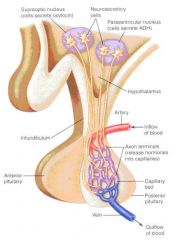
Two parts:
1. Paraventricular 2. Supraoptic Nuclei Function: Produce oxytocin and vaspressin |
|
|
The (3) nuclei of the tubular region are:
|
Regions nuclei of the tubular region are:
1. Ventormedial nucleus 2. Arcuate nucleus 3. Posterior Hypothalamus |
|
|
The (2) nuclei of the Mammillary Region are:
|
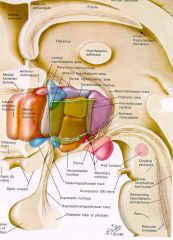
1. Posterior Hypothalamus- projects to SC regulating autonomic responses.
2. Mammillary Bodies - Short-term memory |
|
|
Lateral Hypothalamic Area (LHA)
Location: Function: |
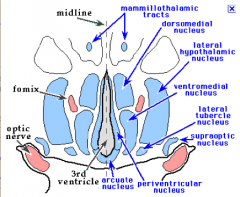
Lateral Hypothalamic Area (LHA)
Location: lies lateral to the fornix and mamillothalamic tract Function: functions related to autonomic aspects of survival |
|
|
What are the (4) afferent pathways to the hypothalamus and what they innervate?
|
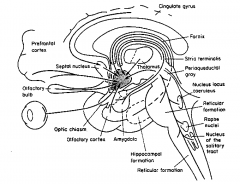
1. Retinohypothalamic tract -->
Suprochiasmatic nucleus (Circadian Rhythm) 2. Fornix - Pre-commissural fibers --> septal region (learning and memory) Fornix - Post-commissural fibers --> Mammilary region (memory) 3. Stria terminalis --> Hypothalamus (Emotion) 4. Ventral Amygdalafugal Pathway --> Hypothalamus (Emotion) |
|
|
What are the two Reciprocal (afferent and efferent) pathways of the hypothalamus and what do they inter-connect?
|
BOTH WAY (Afferent/Efferent) pathways.
1. Medial Forebrain Bundle Interconnects: Hypothalamus, septal region, reticular formation, autonomic nervous system 2. Dorsal Longitudinal Fasciculus Interconnects: hypothalamus, autonomic nervous system. |
|
|
What are the three EFFERENT pathways of the hypothalamus?
|
Efferent Pathways:
1. Mammillothalamic Tract: (MEMORY) Mamm.Bodies --> Ant.Nucleus of Thalamus (PITUITARY GLAND CONNECTIONS:) 2. Hypothalamo-Neurohypophysial Tract: 3. Tuberohyphysial Tract: |
|
|
What do Tuberohypophysial tract fibers release?
|
Tuberohypophysial tract fibers release:
RELEASING and INHIBITORY factions into primary capillar plexus (to ANT.PITUITARY) |
|
|
Where are the Primary capillary plexuses located?
|
The Primary Capillary Plexuses are lovated in the MEDIAN EMINENCE and INFUNDIBULAR STEM.
|
|
|
Where are the Secondary Capillary Plexuses located?
(Hypophysial Portal System) |
The secondary capillary plexuses are located in the ANT.LOBE of PITUITARY.
|
|
|
How are Primary and Secondary Capillary Plexuses different?
|
The Primary Plexus TAKES UP inhibitory and releasing factors.
(Median Eminence and Infundibular System) The Secondary Plexus SECRETES releasing and inhibitory factors. (ANT.LOBE of PITUITARY) |
|
|
Where in the Hypothalamus is Parasympathetic control located?
|
Parasympathetic control: Anterior and Medial Regions.
Activates: Vagus and sacral parasympathtetic innervation |
|
|
Where in the Hypothalamus is Sympathetic control located?
|
Sympathetic control: Lateral and Posterior regions
Activates: SC levels T1-L2/L3 |
|
|
What is the function of the Anterior Lobe of the Pituitary?
|
Anterior Pituitary cells SECRETE HORMONES into circulation.
|
|
|
Emotional Behavior:
Input: Activates: Lesions: |
Emotional Behavior:
Input: Cerebral cortex and limbic system Activates: Hypothalamic initiation of rage and fight/flight behavior Lesions: cause SHAM RAGE REACTIONS Emotional behavior is coordinated with: Sympathetic responses, release of stress hormone. |
|
|
What is the Hypothalamic output of the Stress Response Pathway?
|
Corticotropin-Releasing Factor (CRF) neurons in the "Hypothalamic-Pituitary-Adrenal Axis" (HPA Axis)
|
|
|
Where does CRF act, and what effect foes it have?
|
CRF stimulates the Pituitary to release ACTH.
ACTH = Adrenocorticotropic hormone |
|
|
Where does ACTH axct, and what effect does it have?
|
ACTH binds to receptors in the ADRENAL CORTEX, stimulating the synthesis and release of GLUCOCORTICOIDS
|
|
|
How is the stress response terminated?
|
Glucocorticoids terminate the stress response (negative feedback)
|
|
|
In what three ways does the Hypothalamus play a role in the Neuro-Immune Network?
|
1. Behavioral effects:
- illness symptoms 2. Autonomic effects: - raising body temperature 3. Endocrine effects: - Immunosuppression |
|
|
Effects of Glucocorticoids
|
Glucocorticoids:
1. Stimulate liver gluconeogenesis 2. reduce inflammation and immune responsivity 3. Glucocorticoids terminate the stress response via feedback inhibition of CRF and ACTH. |
|
|
Outline of stess response:
|
Stress:
1. Cortical and limbic system recognizes stress --> 2.CRF is released from HPA-Axis --> 3. ACTH released from pituitary cells 4. Glucocorticoids are released from Adrenal Cortex |
|
|
The Supraoptic and Paraventricular Nuclei synthesis:
(2) Hormones |
1. Vasopressin
2. Oxytocin |
|
|
Damage or destruction of Antidiuretic Hormone Neurons in the SUPRAOPTIC and PARAVENTRICULAR Nuclei can lead to:
|
Diabetes Insipidus
Symptoms: increased urine output, increase need for fluid intake |
|
|
Wat is the function of Oxytocin?
|
REGULATING MATERNAL BEHAVIORS
1. Mediates PARTURITION (maternal labor) 2. Milk letdown reflex |
|
|
Korsakoff's Syndrome:
1. Common patients: 2. Associated with degeneration of _____(2 structues). 3. Deficiency: 4. Clinical Signs: |
Korsakoff's Syndrome:
1. Seen in Chronic ALCOHOLICS 2. Associated with degeneration of MAMMILLARY BODIES and DORSAL MEDIAL thalamic Nucleus 3. Deficiency: THIAMINE (B1) 4. Clinical Signs: Anterograde amnesia, compensatory confabulation, hallucinations. |

